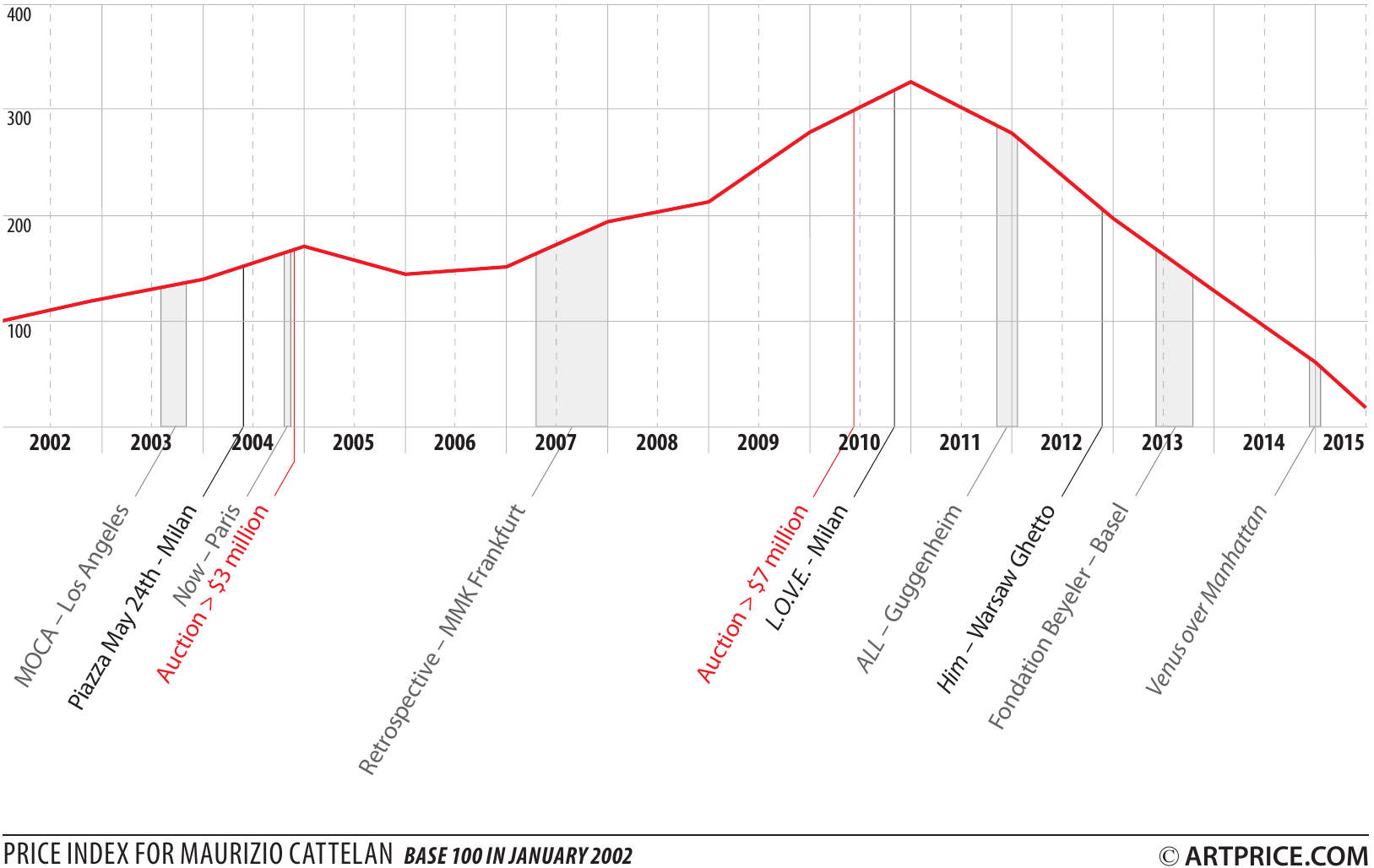Maurizio CATTELAN – a pre-meditated career end
Maurizio CATTELAN became an artist somewhat by accident (after working in a hospital and building furniture, among other jobs), but he became the most mischievous of the art world’s provocateurs. His works combine a substantial dose of derision with a deliberately immature critique of today’s world. Cattelan belongs to that family of artists – direct descendents of Marcel Duchamp – who manage to shake the foundations of the very structures on which they rely, in order to undermine the accepted beliefs of the art world and its market.
For his first invitation to the Venice Biennale in 1993, Maurizio CATTELAN rented out his space to a brand of perfume, which duly erected a large billboard. Two years later, he disguised the owner of the gallery his show was hosted in, Emmanuel Perrotin, as a phallic-shaped pink rabbit (Errotin le Vrai Lapin, 1995). Subsequently invited to exhibit in Amsterdam, he stole the exhibition of a fellow artist from a neighbouring gallery, entitling his show:Another Fucking Readymade!
Maurizio CATTELAN rapidly became an expert in creating provocative and boundary-breaking events and his career has been riddled with heated controversy. He attracted public attention in 2000 with La Nona Ora (the ninth hour), a hyper-realist sculpture of Pope John-Paul II crushed by a meteorite1. The work (adored or detested) caused a scandal that seems to have been extremely beneficial to the artist: La Nona Ora was officially presented at the 2001 Venice Biennial and fetched a superb auction result on 17 May of the same year at Christie’s: $886,000. Three years later (2004) the same piece changed hands for more than $3 million2.
The year 2004 saw Cattelan definitively accepted by the market: having just finished an exhibition at the MOCA in Los Angeles he precipitated yet further outrage in Milan’s Piazza 24 Maggio by hanging (literally) three wax models of children in a large tree. The work attracted even more media attention after a man was seriously injured attempting to detach the mannequins.
That year, he also exhibited at the Louvre in Paris, the Serpentine Gallery in London, the Marian Goodman Gallery in New York, in Spain, in Greece, and in Italy. In short, Cattelan had acquired dense international exposure and he enjoyed a series of new auction records: in just 12 months, his auction turnover rose nearly 600%.
Cattelan’s impressive market ascension reached its highpoint in 2010 when a new record of $7.9 million was paid for an installation showing him climbing out of a hole in the floor3 (which meant that the new owner had to sacrifice his floor). Previously sold for $2million in 2004, the return on the original investment was therefore 290% in just six years. That was probably the right time to sell the work because since then none of his works have fetched anywhere near that sum.
At the same time, his one-man show at Milan’s Palazzo Reale at the end of September 2010 provoked yet further controversy with a work titled L .O.V.E ., an eleven-metre-high marble middle-finger, installed right in front of the Milan stock ex-change… that was subsequently removed.
When the New York Guggenheim offered him a retrospective in 2011 (Maurizio CATTELAN: All), he decided to suspend his works like trinkets from the ceiling about the Museum’s superb rotunda, announcing seriously, but casually, the end of his artistic career! Although his news-flow did not end with the Guggenheim’s homage, his market contracted for a while to digest the news of his “retirement from art”
However, it appears to be waking up: a number of his major works have appeared at auction in recent months, including a sculpture representingPablo PICASSO that unfortunately failed to sell on 30 June 2015 in London… Christie’s appears to have over-estimated the work at between $1.9 million and $2.8 million, whereas it was acquired for just $400,000 in 2007. On the other hand his stuffed ostrich with its head in the ground (Ostrich, 1997), sold for $2.4 million, whereas nobody wanted it at half that price ten years ago.

Cattelan’s Ostrich perfectly embodies one of the major questions posed by the Italian artist: should we bury our heads in the sand? And it looks like Maurizio CATTELAN’s short but deviant career will remain an important chapter in the art history of the early 21st century.
- Exhibition Apocalypse, Royal Academy in London.
- At Phillips de Pury & Company, 11 November 2004.
- Untitled (2001), ed. 3/3, 12 May 2010 at Sotheby’s.





 0
0
